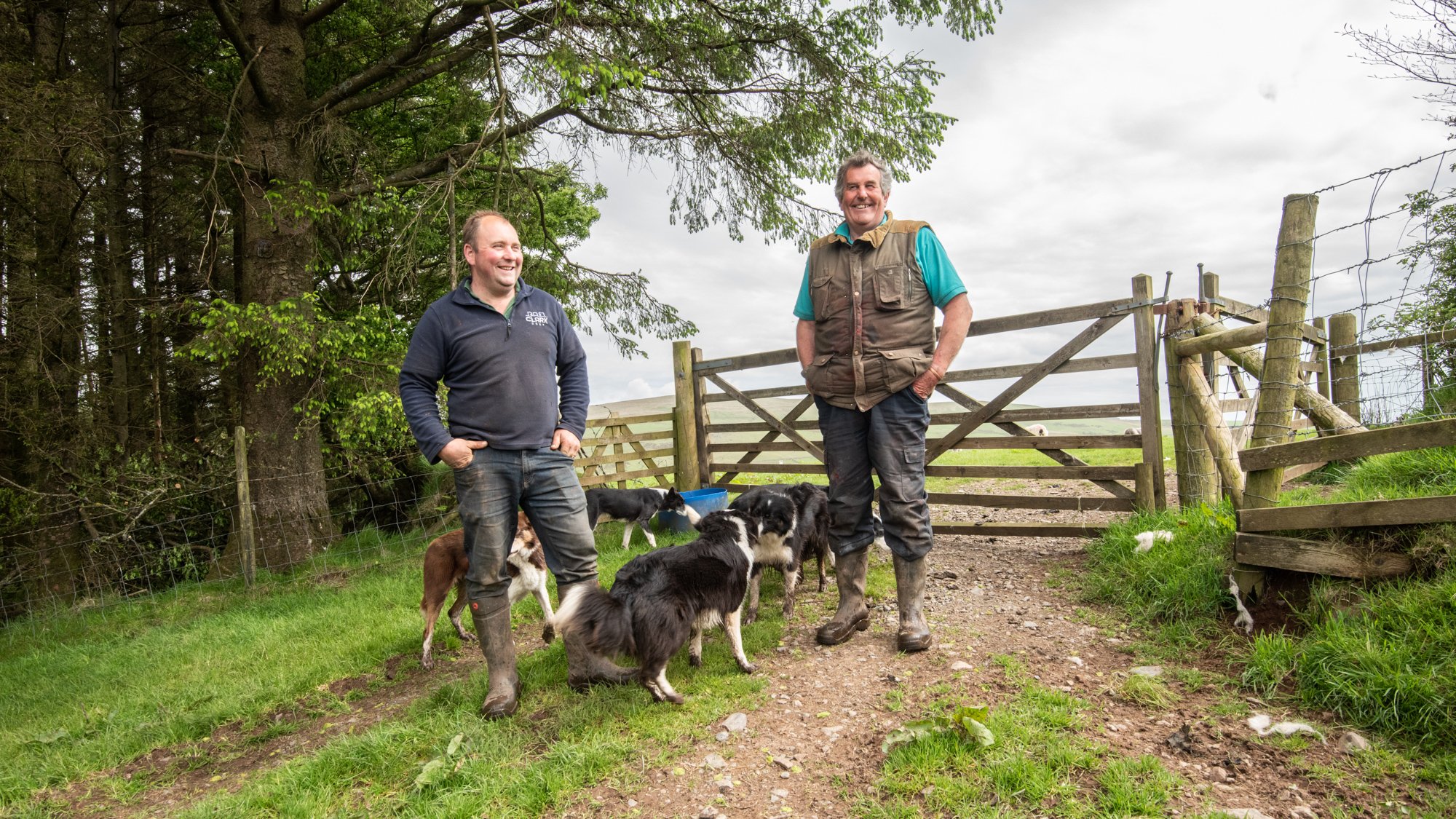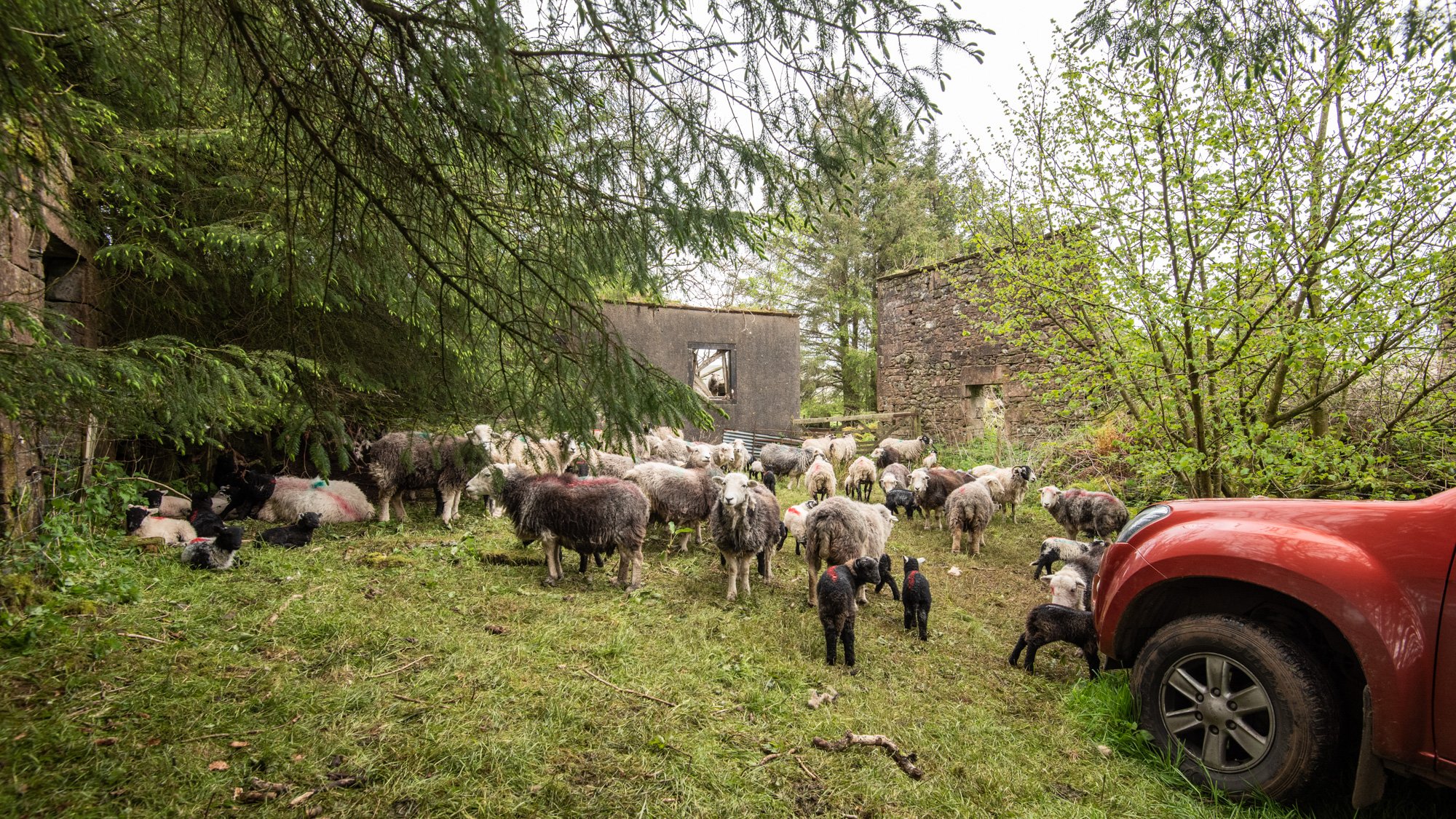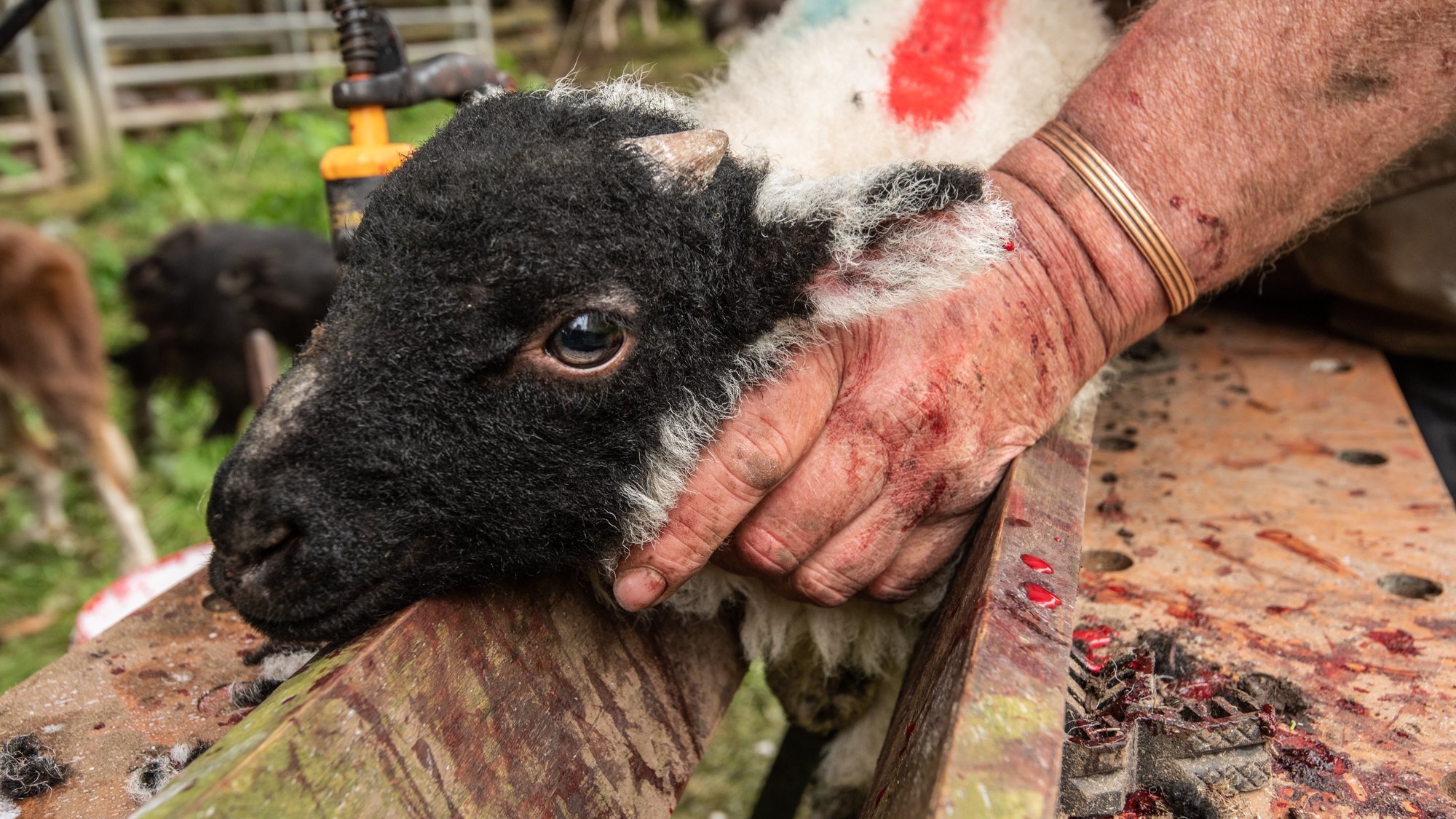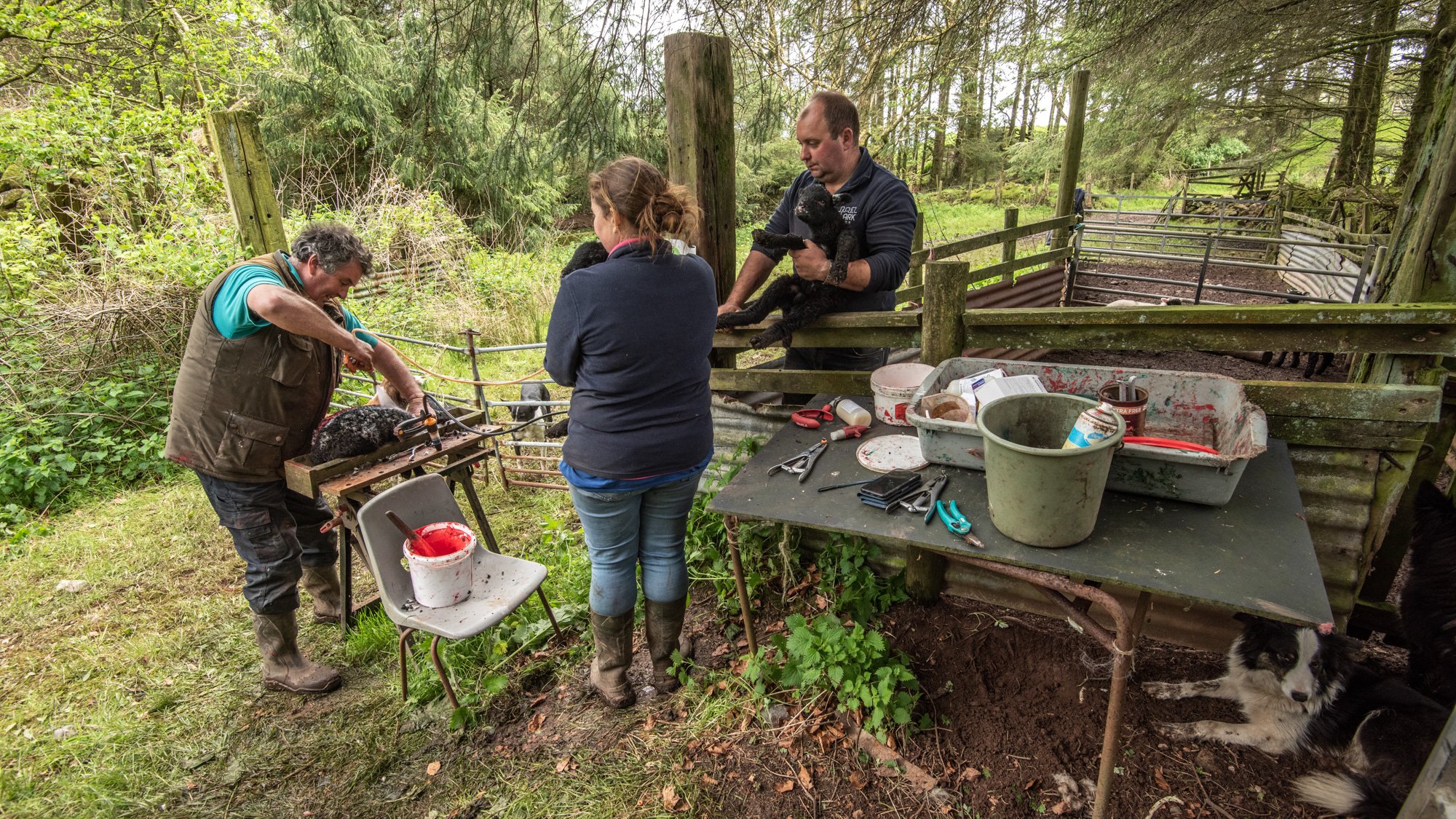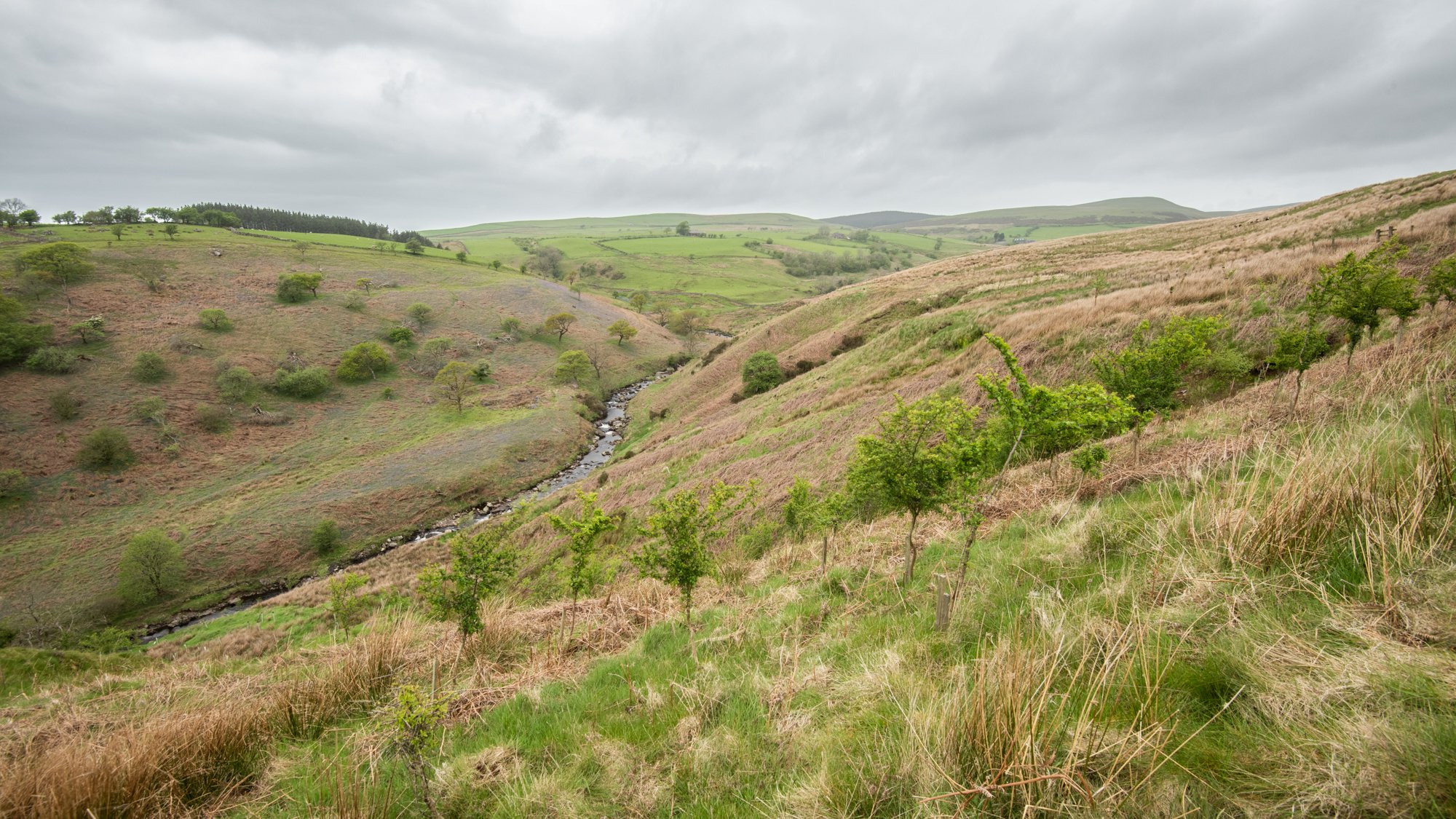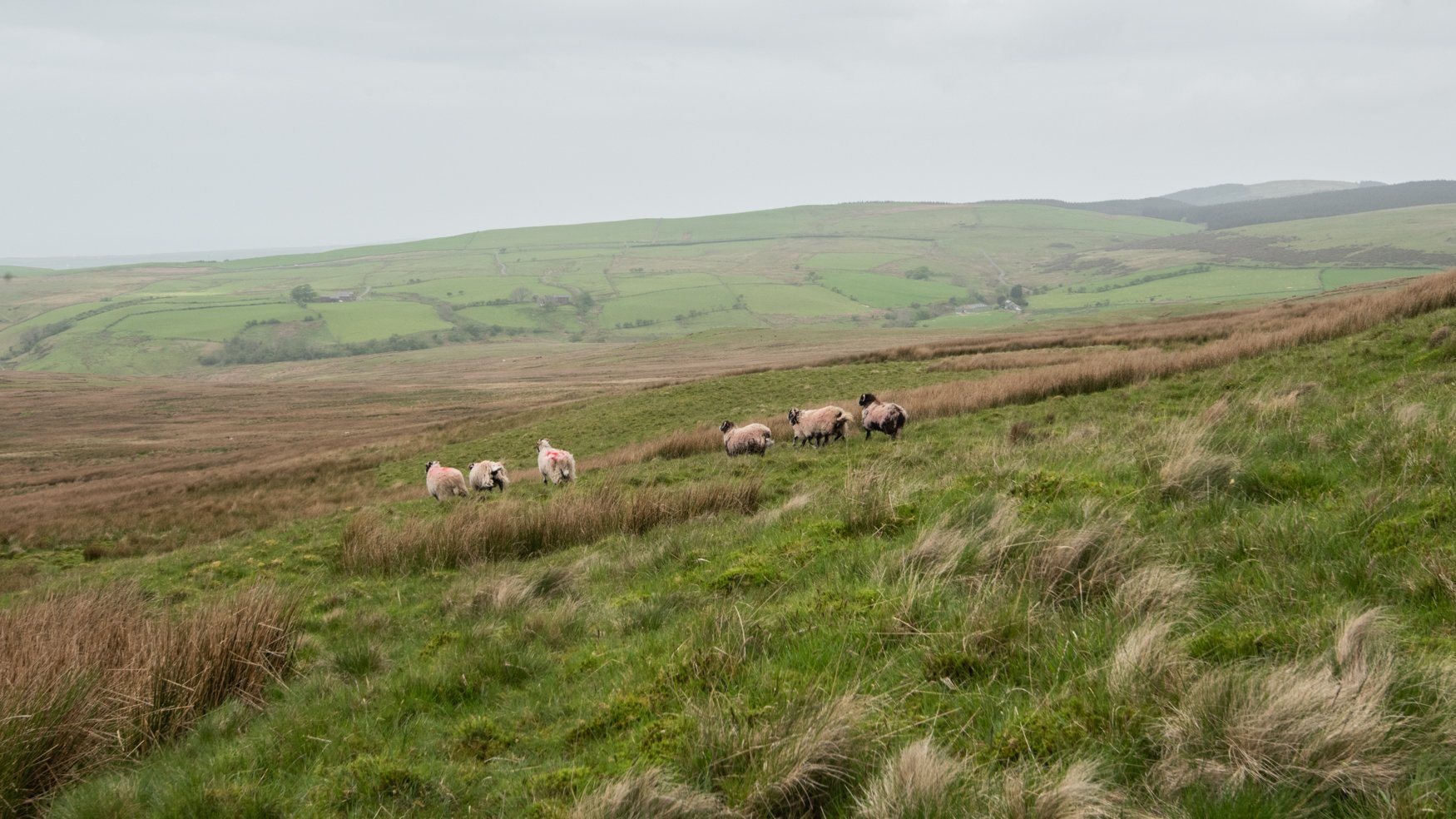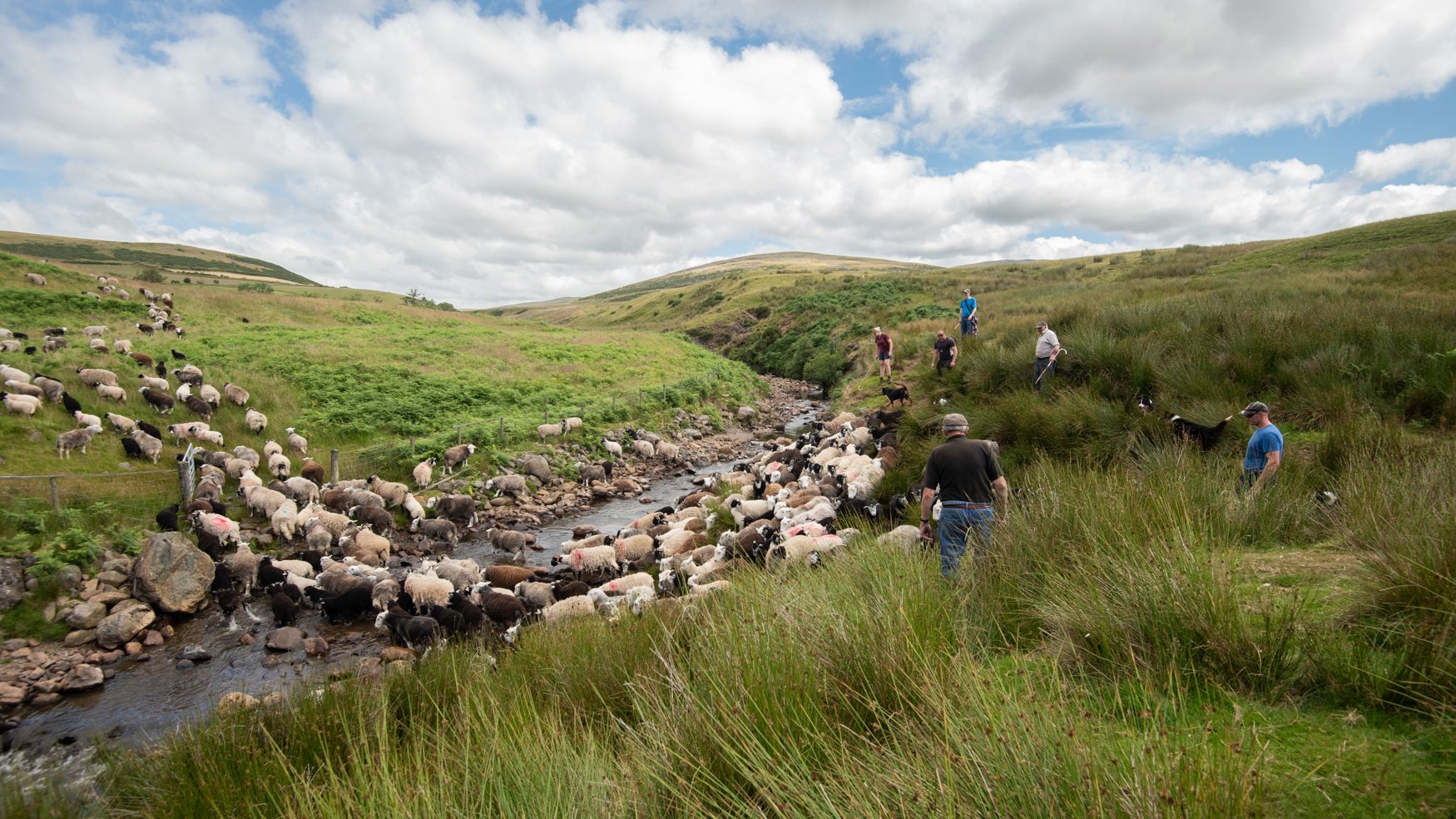Meeting some of the Kinniside Commoners
Pete, Vicky and Kevin, with Kinniside Common behind
““I’ve always had peace and tranquillity, coming to look over the fell. Sometimes you can have a bad day but you can just let the dogs out, come up onto the top of here, and look out, and you can chill, let all the badness drain out.” ”
Kevin Holliday has been going out onto Kinniside Common for 50 years. He farms from Side Farm, which adjoins Kinniside Common, and neighbouring Strudda Farm, working in partnership with his daughter and son-in-law, Vicky and Pete Slater. Vicky and Pete have three children, aged 13, 10 and 6.
We meet Kevin under the trees around Side Farm with his daughter Vicky and her husband Pete, marking up this year’s lambs. The farm’s buildings have long been out of use, and are slowly being taken over by greenery, but its land is still an important part of the business. The air is thick with the sounds of the lambs bleating, and in careful order each one is lifted and checked by Pete and Vicky, who give them medication to protect them against fly strike. Any male lambs are castrated (by placing an elastic band around the testicles). Kevin then marks each sheep with a bright red smit mark, and clips its ear. These markings are essential once the sheep are let out onto Kinniside Common.
Being a commoner
I ask Kevin what the common means to him. He smiles, and has plenty to say about how much he loves it. Practically, though, it’s an integral part of farming. “A common can be anything from a village green to a thousand acres set up on the top of the Fells. To us, the common gives us rights to go to graze from our pastoral farm.”
The farm consists of inbye land (the best fields) and intakes, which are slightly rougher fields that are walled in. The common is beyond these. The three areas are used at different times of year; for instance, the lambs are currently in the inbyes, but later this year will go out to the more exposed land of the common. Kevin knows the wide, open space intimately, and knows where his animals go.
“You don’t just acquire the knowledge overnight - 50 years on, I’m still learning! I learned off the old fellas before me, and I’m trying to pass that down to the next generations. ”
“You don't just acquire the knowledge overnight - 50 years on, I'm still learning! I learned off the old fellas before me, and I'm trying to pass that down to the next generations. You need to learn how the sheep gather, how the cows gather. Those cows know my voice: I go up there every other day to see them, smile at them, stroke them. I know them all by name.”
Kevin is one of a group of commoners who have rights to graze on Kinniside Common. Kinniside adjoins Stockdale Moor, which runs to Nether Wasdale - a series of commons that join one another and are not separated by fences. Commoners, or graziers, as they are also called, often work together. “I feel a part of a community. There's 18 commoners on there and when it’s time to gather in the sheep, there will be a few phone calls, a few text messages, and we'll go together. There’s a feeling of pride as you go out onto that fell. We meet up on the top, have a little bit of a chinwag, and then set off with our dogs.”
Change over time
Over the years the numbers of sheep on the commons has changed. Following the war, the government encouraged high stocking levels through ‘headage’ payments, or payments per sheep. Since the 1980s, agri-environment schemes have encouraged a reduction in numbers of sheep to ease pressure on vegetation. Stocking density has been going down over the decades. “When I first came out here, there was a lot of competition because of the headage payment. Numbers have come down from 10,000, to 5000, to 2000 sheep.”
Although overall numbers are down, there’s a core flock at each farm, and a knowledge of the common that’s passed down from the ewes to their lambs. “If you buy this farm now, you buy the hefted flock, because they live on that particular fell, and they know the flora, the fauna, the good grass, the shelter. The hefting system has been destroyed a bit recently: some flocks have moved off completely, and other sheep have moved into the vacuums. So the gather that I did 40 years ago is different to the what I’d do now - not a lot, but with some little changes.”
Kevin’s herd of cows includes Herefords and Blue Greys. “Our cows go to the top of the Fells. They’re very good for the environment: as they travel around, find the lush pieces of grass, and graze the roughness off - they don’t nibble right down like sheep do.” Kevin is proud that the cows are doing really well. “We've done surveys and we weigh them as they go out and we weigh them as they come off the fell. They do equally as well as the cattle on the inbye land.” This is good for the cows and for the farm, as it means they don’t need extra resources, and don’t have to be kept inside.
Love and care - and challenges
Farming isn’t only about the livestock - it’s also about the land, and Kevin clearly loves it. “I've always had peace and tranquillity, coming to look over the fell. Sometimes you can have a bad day but you can just let the dogs out, come up onto the top of here, and look out, and you can chill, let all the badness drain out.”
Kevin’s approach to the common is as a whole system, with varied habitats, connected to the lower ground. He’s keen to increase tree cover and create more wildlife corridors across his farm’s land and linking with neighbouring farmers. “We plant in the order of two- to three-thousand trees a year, mostly in hedges, and we're planting hardwoods now - we're trying to take the conifers out. I don’t want the hedgerows to be bland. I want them with all species - cherry, damson, all sorts, to feed the birds as well. We've got a lot of smaller birds, and we have a hen harrier coming over. We've got peewits nesting, and curlews too. We’ve lessened the rushes here because we found that the fox was slipping through them, sneaking through to take the eggs. Now we’ve cleared areas, and we’ve had young curlews.””
Kevin’s enthusiasm about a life of farming is infectious. But I’m well aware that there are many challenges. I wonder, what’s the biggest challenge he’s facing at the moment?
“When I set off 20 years ago, I could go to the bank manager with a balance sheet and a budget, and know what was going to happen for the next 5-10 years. I wouldn't like to try and do a balance sheet at the moment with all the uncertainties.” For some people, the likelihood of a farm surviving long-term seem very low. While we stand in the field, looking across to the common, I hear the mews of buzzards circling, and the crawking of rooks. The tone changes.
“Somebody rang me last week ... They said there’s a potential purchaser of your land, wants to buy it, and plant it up. ”
“Somebody rang me last week,” Kevin continues. “They said there's a potential purchaser of your land, wants to buy it, and plant it up. I put it to the partnership. Pete says, I'm just learning, just getting my head round this farm, I’m not ready to give it to planting. I rang the fella up and I said, well, at the moment the people that are in their prime want to farm on. But we will put you on file for the next three or four years.” His eyebrows raise. “Who knows, you might be standing in the middle of a forest in 10 years’ time. I wouldn't like to say it. Neither would my grandfather or my mother, because we've looked after and tended this farm for years. And look at it: it's in very, very good order, it's got good heart in it. But it's a business that needs to work - no matter how well you farm, if it's unsustainable, then we've got to find a solution.”
Partnership, and cross-generational work
On this note, I turn to Vicky to find out what her view is. She works in partnership with her dad, and brings a slightly different perspective. “I was born on the farm and grew up on the farm. I went to university and did a teaching degree and went to work in nurseries and things for a few years. Then I came back onto the farm. I think farming is not really a job. If it was a job you wouldn't do it, it's not nine to five. The pay is not brilliant, but it's a lifestyle. And I love it. And that's why I've come back to it.”
Not all families would take on the challenge of working as a partnership, but Vicky says it’s going well. “We've got the experience of dad and then we've got the youth of us coming in, and working maybe a little bit harder, and probably a bit more risk-taking. But we always look back to dad, for his experience. And if dad wasn't here, we'd look through his diaries, which he’s filled in every day.”
As well as being part of the farm partnership, Vicky works with the Farmer Network and has a part time job in a printing business. She’s also involved in the West Lakeland CiC, which brings commoners and others together to share learning and planning for a sustainable future. Their emphasis is on grassroots, farmer-led nature recovery partnerships, working in ways that suit the idiosyncrasies of each individual valley and common. (Find out more about the West Lakeland CiC here).
Pete, Vicky and Kevin, with Kinniside Common in the background
Vicky has three children, and is keen to emphasise to them just how lucky they are. “It's freedom. We see it every day and maybe we take it for granted, but when you actually look, you realise how beautiful it is.” At Strudda Bank Vicky takes charge of the luxury camping pods. “We put the pods in because I thought: why don't we share it? People come, and they're just mesmerised. They love getting out in the fresh air. We get people from the middle of Manchester coming and they love the fact that they can see the stars because there's no light, nowhere. No light pollution.”
Pete works full time on the farm with Kevin. His father is a builder, but Pete was drawn into the idea of farming by his grandfather who worked as a herdsman on a dairy farm. Pete helped out on a dairy farm for 16 years, but it was through meeting Vicky that he’s made the transition to hill farming. It feels like a different community, he says, “there was no community where I was at really, your worked on your own and that was it.”
You can find out more about the farm, and staying in a glamping pod, here: https://www.struddabankfarm.com/


